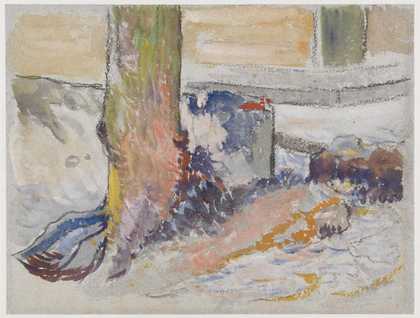
Paul Gauguin
Faa Iheihe (1898)
Tate
Paul Gauguin was born in Paris on 7 June 1848 and died at Hiva-Oa, the largest island in the Marquesas group, on 8 May 1903.
At the age of seventeen, he yielded to wanderlust and, for six years, sailed the oceans of the world in freighters and men-of-war, visiting South America, India, Scandinavia and other parts of the globe.
From being a sailor, he turned in 1871 to being a Parisian stockbroker, a career in which he soon became so successful that, in 1873, he was able to marry a Danish girl, Mette-Sophie Gad, and settle down to family life.
During these two years Gauguin had developed an amateur interest in art which was fanned both by his guardian Gustave Arosa, the owner of a notable collection of pictures (Corot, Delacroix and the Barbizon School) and by Emile Schuffenecker, a fellow employee in the broker’s office where he worked.
Schuffenecker also persuaded Gauguin to try his hand at painting and the two of them indulged in this hobby on Sundays.
In 1876 the jury of the Salon accepted a painting (Paysage à Viroflay) which Gauguin had submitted. This would not be surprising but for the fact that his style was already being influenced by Jongkind and the Impressionists. We do not know when Gauguin first saw Impressionist pictures, though it was probably at the First Impressionist Exhibition in 1874.
Encouraged by this auspicious beginning Gauguin decided to devote his entire life to art.
In January 1883, therefore, he suddenly resigned from his firm of stockbrokers in order to be free at last ‘to paint every day’.
Yet, as he knew well, something vital was still lacking in his work: colour. The nature and possibilities of this essential element were revealed to him in the spring of 1886 at the Eighth Impressionist Exhibition where his own pictures hung beside those of Signac and Seurat (La Grande Jatte).
Then in 1887 came the great experience of Martinique, with its brilliant colouring, tropical vegetation and simple population living the natural life.
Synthétisme was Gauguin’s ‘frank return to the beginning’, his calculated attempt to break through the artistic canon of Reason and Reality, which was the heritage of the Graeco-Roman tradition, and to create the sort of image which did not appeal simply to the eye but would strike the imagination and stimulate the soul of man.
Douglas Cooper


